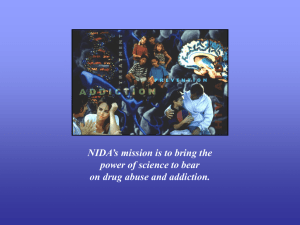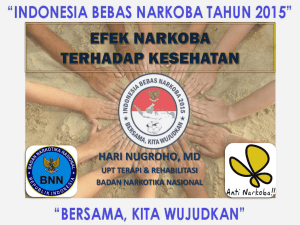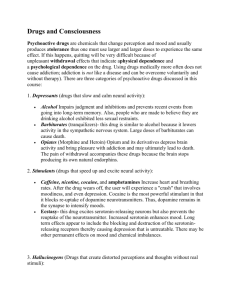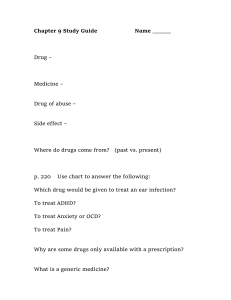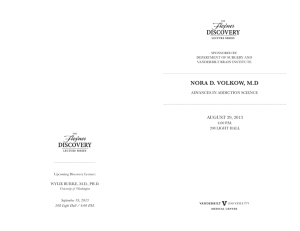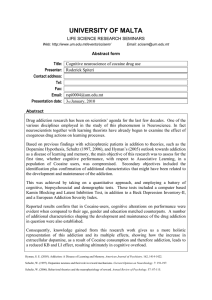Addiction: It’s a Brain Disease Beyond a Reasonable Doubt
advertisement
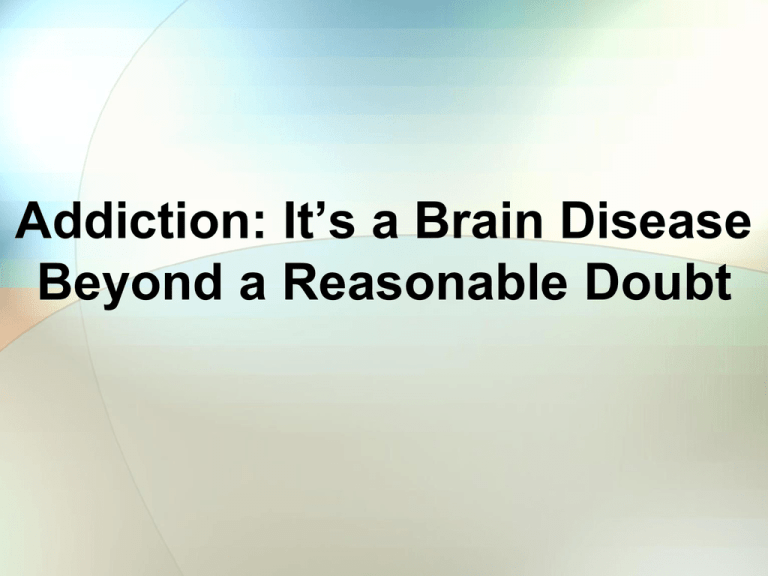
Addiction: It’s a Brain Disease Beyond a Reasonable Doubt Estimated Economic Cost to Society from Substance Abuse and Addiction: Illegal drugs: $181 billion/year Alcohol: $185 billion/year Tobacco: $158 billion/year Total: $524 billion/year Surgeon General’s Report, 2004; ONDCP, 2004; Harwood, 2000. Contributors to the Economic Costs of Substance Abuse and Addiction • Health care expenditures – Alcohol and drug abuse services – Medical consequences • Productivity (lost earnings) – – – – – Premature death Impaired job performance Institutionalized population Incarceration Criminal victimization • Other impacts on society – Crime – Social welfare administration – Vehicular accidents Adapted from Harwood et al., Addiction, 1999. Between 50% and 80% of Adult Male Arrestees Tested Positive for Illicit Drug Use in 2000 100% 90% 80% 70% 60% 50% 40% 30% 20% Drug Use Correlates with Crime 0% Albany Albuquerque Anchorage Atlanta Chicago Cleveland Dallas Denver Detroit Honolulu Indianapolis Miami New Orleans New York Philadelphia Phoenix Portland Sacramento San Antonio San Diego San Jose Seattle Spokane Tuscon 10% 2000 Arrestee Drug Abuse Monitoring: Annual Report, April 2003. The Perpetrator is Involved in Drug Use in… • • • • More than 50% of violent crimes 60-80% of child abuse and neglect cases 50-70% of theft and property crimes 75% of drug dealing Belenko and Peugh, 1998; National Institute of Justice, 1999. What is Addiction? • • • A brain disease expressed as a compulsive behavior The continued abuse of drugs despite negative consequences A chronic, potentially relapsing disorder Why Do People Take Drugs in The First Place? To feel good To have novel: feelings sensations experiences AND to share them To feel better To lessen: anxiety worries fears depression hopelessness Vulnerability Why do some people become addicted while others do not? There’s a Big Genetic Contribution to Drug Abuse and Addiction… ….Overlapping with Environmental Influences that Help Make Addiction a Complex Disease. DA Receptors and the Response to Methylphenidate (MP) Low DA receptor high low Dopamine receptor level High DA receptor As a group, subjects with low receptor levels found MP pleasant while those with high levels found MP unpleasant Adapted from Volkow et al., Am. J. Psychiatry, 1999. How Do Drugs “Work”? Initially, a person takes a drug hoping to change his or her mood, perception, or emotional state Translation – …hoping to change their brains. We know that despite their many differences, most abused substances enhance the dopamine and serotonin pathways Circuits Involved In Drug Abuse and Addiction All of these must be considered in developing strategies to effectively treat addiction dopamine transporters Natural Rewards Elevate Dopamine Levels SEX 200 % of Basal DA Output NAc shell 150 100 Empty 50 Box Feeding 200 150 100 15 10 5 0 0 0 60 120 Time (min) Di Chiara et al., Neuroscience, 1999. 180 Copulation Frequency DA Concentration (% Baseline) FOOD Female Present Sample Number 1 2 3 4 5 6 7 8 Fiorino and Phillips, J. Neuroscience, 1997. Mounts Intromissions Ejaculations Effects of Drugs on Dopamine Release NICOTINE 200 % of Basal Release % of Basal Release 250 Accumbens Caudate 150 100 0 % of Basal Release 400 Accumbens COCAINE DA DOPAC HVA 300 200 100 0 0 1 2 3 4 Time After Cocaine Di Chiara and Imperato, PNAS, 1988 5 hr 1100 1000 900 800 700 600 500 400 300 200 100 0 MORPHINE Dose (mg/kg) 0.5 1.0 2.5 10 200 150 100 0 1 2 3 hr Time After Nicotine % of Basal Release 0 Accumbens 250 0 1 Accumbens 2 3 4 Time After Morphine 5hr METHAMPHETAMINE DA DOPAC HVA 0 2 3 4 1 Time After Amphetamine 5 hr Science has generated much evidence showing that… prolonged drug use changes the brain in fundamental and long-lasting ways Dopamine D2 Receptors are Lower in Addiction DADA Cocaine DA DA DA DADA Meth DA DA DA DA DA Reward Circuits Non-Drug Abuser DADA Alcohol DA DA DA DA Heroin Reward Circuits Control Addicted Drug Abuser Dopamine Transporters in Methamphetamine Abusers Normal Control Dopamine Transporter Bmax/Kd Motor Task 2.0 1.8 1.6 1.4 1.2 1.07 Loss of dopamine transporters in the meth abusers may result in slowing of motor reactions. 8 9 10 11 12 13 Time Gait (seconds) 2.0 1.8 1.6 1.4 1.2 1.0 16 14 12 10 8 Memory task Loss of dopamine transporters in the meth abusers may result in memory impairment. 6 4 Delayed Recall (words remembered) Methamphetamine Abuser Volkow et al., Am. J. Psychiatry, 2001. . Implication: Brain changes resulting from prolonged use of drugs may compromise mental and motor functions DCRAVING CRAVING INDUCTION IN A PET SETTING 5 4 3 2 1 0 -1 N = 13 Neutral Cocaine Conditioned Association STIMULI 2.5 2.0 1.5 1.0 .5 0 Nature Video Cocaine Video Childress et al., Am. J. Psychiatry, 1999 Memories Appear to Be A Critical Part of Addiction “Its about people, places and things…” Cocaine Craving: Population (Cocaine Users, Controls) x Film (cocaine, erotic) Signal Intensity (AU) Cingulate Ant. Cing. Cocaine Cocaine Film Film Erotic Film IFG Controls Cocaine Users Garavan et al., Am. J. Psychiatry, 2000. Drugs Are Usurping Brain Circuits and Motivational Priorities Treatment and the Cycle of Addiction Addiction is the Quintessential Biobehavioral Disorder Drug Addiction: A Complex Behavioral and Neurobiological Disorder Psychological - Prior experience - Expectation - Learning Drugs Environmental - Social interactions - Stress - Conditioned stimuli Brain Mechanisms Behavior Environment Physiological - Genetics - Circadian rhythms - Disease states - Gender Addiction Changes Brain Circuits Non-Addicted Brain Addicted Brain Control Control Saliency Drive NOT GO Saliency Memory Source: Adapted from Volkow et al., Neuropharmacology, 2004. Drive GO Memory This is why addicts can’t just quit This is why treatment is essential Treating a Biobehavioral Disorder Must Go Beyond Just Fixing the Chemistry • Pharmacological (medications) • Behavioral Therapies • Medical and Social Services Treatment Can Work But, drug addiction is a chronic illness with relapse rates similar to those of hypertension, diabetes, and asthma McLellan et al., JAMA, 2000. Drug Addiction Type I Diabetes Hypertension McLellan et al., JAMA, 2000. 50 to 70% 50 to 70% 90 80 70 60 50 40 30 20 10 0 30 to 50% 100 40 to 60% Percent of Patients Who Relapse Relapse Rates Are Similar for Drug Addiction & Other Chronic Illnesses Asthma Addiction is Similar to Other Chronic Illnesses Because: • Recovery from it--protracted abstinence and restored functioning--is often a long-term process requiring repeated treatments • Relapses to drug abuse can occur during or after successful treatment episodes • Participation in self-help support programs during and following treatment can be helpful in sustaining long-term recovery Therefore… There is a right way and a wrong way to Measure the Outcome of Treating Chronic Illnesses like Addiction Hypertension Tx 8 7 6 5 4 3 2 1 0 8 7 6 5 4 3 2 1 0 YES Pre During Stage of Tx Addiction Tx Post NO Pre During Stage of Tx Post Full recovery is a challenge but it is possible … [C-11]d-threo-methylphenidate DAT Recovery with prolonged abstinence from methamphetamine Normal Control high Methamphetamine Abuser (1 month detoxification) Methamphetamine Abuser (14 month abstinent) Volkow et al., J. Neuroscience, 2001. low Treatment Reduces Drug Use and Recidivism Percentage of Participants Delaware Work Release Therapeutic Community (CREST) + Aftercare 3 Years After Release (N=448) p < 0.05, compared to No Treatment group Drug-Free Arrest-Free
